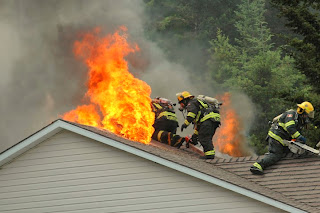For National Chimney Safety Week September 9 to 18, 2015 the Midwest Chimney Safety Council reminds homeowners and restaurant owners to be diligent about maintaining their chimneys serving fireplaces, furnaces, boilers, wood stoves, and restaurant ovens.
 |
| fotolia.com |
The United States Consumer Product Safety Commission released the latest statistics for residential structural fires which indicates that 21,200 hostile fires were attributed to fireplaces, chimneys or chimney systems in 2012, with an average of 22,700 occurring annually from 2010 to 2012. According to the National Fire Protection Association in 2011 heating equipment was involved in an estimated 53,600 reported U.S. home structure fires, with associated losses of 400 civilian deaths, 1,520 civilian injuries, and $893 million in direct property damage.
While these numbers continue to decline due to public-awareness efforts by the Midwest Chimney Safety Council, the Chimney Safety Institute of America, chimney sweep companies and firefighters, the message is still not getting to everyone.
 |
| From the NFPA |
The National Fire Protection Association recommends
annual inspection of flues of all types that serve gas or wood-burning
appliances, and sweeping as necessary to remove flammable creosote. Creosote
should be removed when ¼” has accumulated on the flue walls. Depending on the
amount of wood burned restaurant ovens usually need monthly or bi-monthly
sweeping, open fireplaces typically need annual sweeping, and wood stove flues
and chimneys may need sweeping two or three times during the burning season.
Creosote accumulates when any type of wood is burned
including hardwoods. Gas appliances don’t produce creosote, however, the flue
needs to be in good condition or it could be a carbon monoxide hazard. Common
issues with gas flues are gaps or cracks in flue liners, clogs in liners, and
missing flue liners. Correct flue sizing is critical to proper operation. This
is something a professional chimney sweep can check when doing an inspection.
The MCSC recommends that a professional chimney sweep
who is certified by the Chimney Safety Institute of America do the inspection
and sweeping. CSIA Certified Chimney Sweeps are trained in sweeping methods,
inspections, codes, and clearances. The proper equipment is needed to do a
thorough inspection and remove creosote, which involves a chimney camera system
and other tools of the trade.
There are now over 1,500 CSIA Certified Chimney Sweeps
across the United States with more added annually. To find a professional
chimney sweep visit the Midwest Chimney Safety Council website at www.mcsc-net.org
or the Chimney Safety Institute of America website at www.csia.org.
_________________
Marge Padgitt is the president of the Midwest Chimney Safety Council and a 30+ year industry veteran. She is a CSIA Certified Chimney Sweep and NFI Woodburning Specialist. Contact Marge at margepadgitt (at) comcast.net.
No comments:
Post a Comment
Note: Only a member of this blog may post a comment.